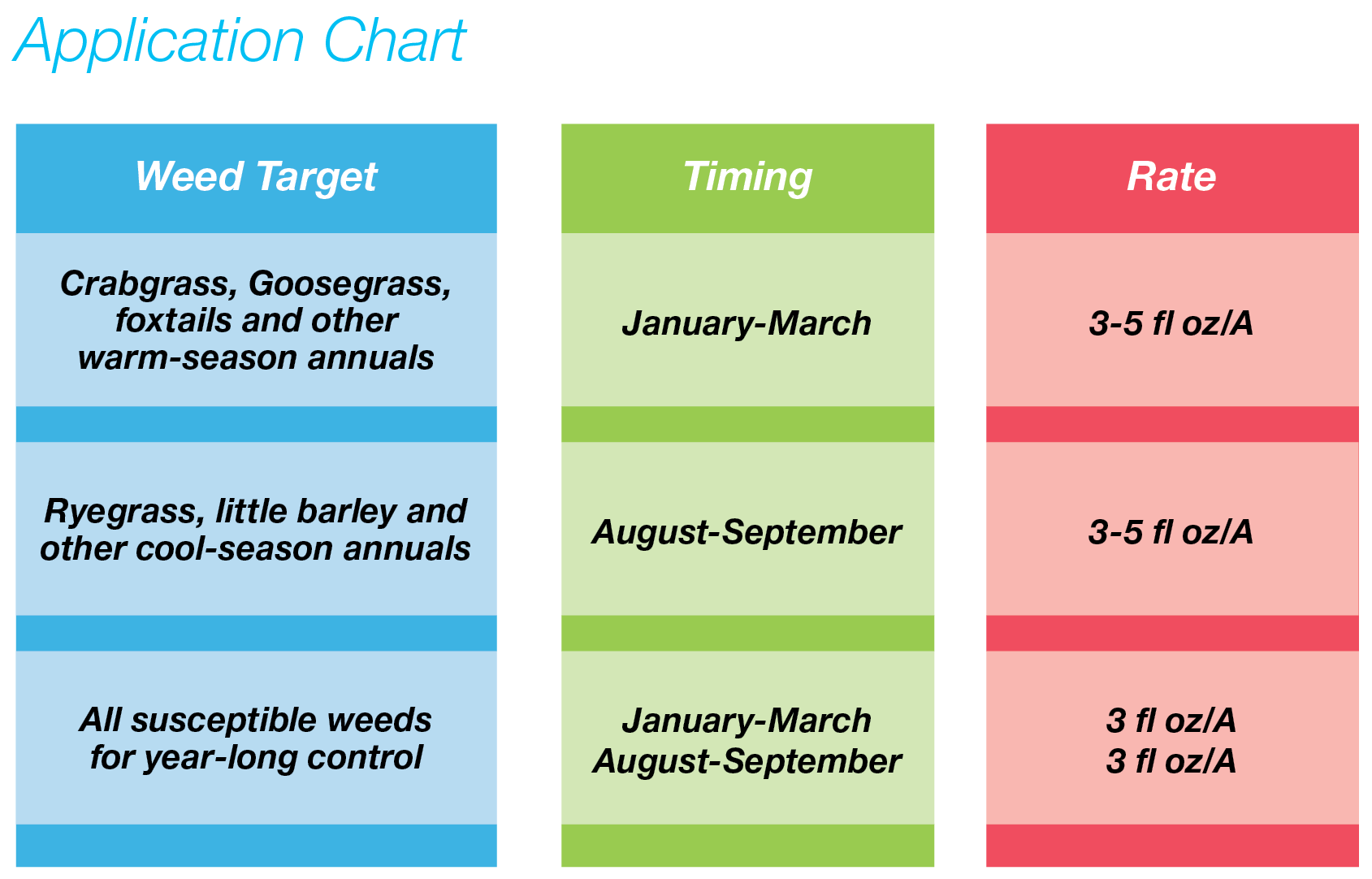Stewardship
Guidelines for Optimum Use
Rezilon is a pre-emergence herbicide that must be incorporated into the soil by rainfall or irrigation, where it inhibits root growth as seeds germinate. It has limited or no post-emergence activity on weeds that have germinated or are perennial species, so it is critical to make the application well before weed germination is expected. One important rule of thumb to remember with Rezilon is "Early is on time." Getting applications out several weeks in advance of weed germination is not a problem. Unlike many other herbicides, Rezilon can remain the soil surface with limited degradation from sunlight until an activating rainfall or irrigation is received.
Uniform spray distribution using flat-fan nozzles, or similar, that produce medium-to-coarse droplets is necessary to achieve the best possible weed control with Rezilon. It is recommended that applications be made at 15 gallons/A or higher with a boom-type sprayer. Boomless sprayers are not recommended as these may not provide uniform coverage and may result in reduced performance.
Application Rates and Timing
Rezilon may be applied at rates of 3-5 fl oz/A in a single application and no more than a total of 6 fl oz/A in a 12-month period.
- For season-long control of annual weeds, make an application of 3 fl oz/A in late winter with a second application of 3 fl oz/A in mid-to-late summer.
- For control of warm-season annual species such as crabgrass, apply Rezilon at 3-5 fl oz/A in late winter (February), well before germination of summer annual weeds.
- For control of winter annuals, such as ryegrass, make an application of 3-5 fl oz/A in late summer (August-September), prior to winter weed germination.
A good rule of thumb is to make applications by Valentine’s Day to target summer weeds and by Labor Day for winter weed control.
Growing season Applications
Rezilon should never be applied to a harvest-ready crop as this increases the chance of it being removed through the harvest. Applications made during the growing season should be completed soon after a cutting, prior to significant stand regrowth. This limits foliage intercepting the spray, ensures good soil contact (which is necessary for activation), and minimizes the amount of product removed from the field through harvested hay. If foliage interception of the spray occurs and an incorporating rainfall is not received prior to harvest, poor weed control may result. In addition, hay treated in this manner should not be used as mulch or a soil amendment in gardens, around bedding plants, or fed to animals whose raw manure may be used in gardens, as some herbicide may remain and impact desirable plants.
Key Species Controlled
Rezilon controls more than 60 species of annual grasses and broadleaf weeds, including some of the most troublesome grass species.
- Ryegrass
- Crabgrasses
- Goosegrass
- Barnyardgrass
- Foxtails*
- Sandbur*
*Post-emergence tank mix partner is required for control of established, perennial plants.
Important Considerations
// Rezilon should only be applied to fields that are well-established (at least one growing season). Treatment prior to complete canopy cover may delay fill-in of the grass stand by restricting new stolon growth from rooting down into treated soil.
// There are no grazing restrictions for fields treated with Rezilon. However, animals grazing heavily in an area treated with Rezilon may disturb the soil surface and have a negative impact on weed control. An example of this would be animals feeding around a hay ring.
// There are no harvest restrictions for hay when treated with 3 fl oz/A. If higher rates are used in a single application, hay cannot be harvested until 40 days after application.
// Fields that have been treated with Rezilon cannot be seeded with winter forages (such as ryegrass or clover) used for winter grazing until 18 months after the last application as their germination and growth may be adversely affected.
// Other crops may not be planted until 22 months have passed since the last application of Rezilon.
// Hay harvested from fields treated with Rezilon may not be sold or shipped to countries that do not have established maximum residue levels (MRLs) for indaziflam-treated hay.
Resistance Management
Rezilon (active ingredient indaziflam) has a specific mechanism of action (MOA) classified as a cellulose biosynthesis inhibitor (CBI) and is designated as a group 29 herbicide by the WSSA. Currently, there are no cases of cross-resistance. However, growers should always take steps to ensure that resistance does not become an issue on their farms. Prevention of weed resistance should always be at the forefront of any weed management plan. For Rezilon, this plan should include tank-mixing herbicides with different MOAs during the PRE application, controlling any weeds that escape the PRE application with post-emergence (POST) herbicides, or mechanical means such as mowing, to control any escapes before seeds are produced. Taking these steps will help ensure Rezilon will continue to be a viable choice for hay producers for many years to come.

